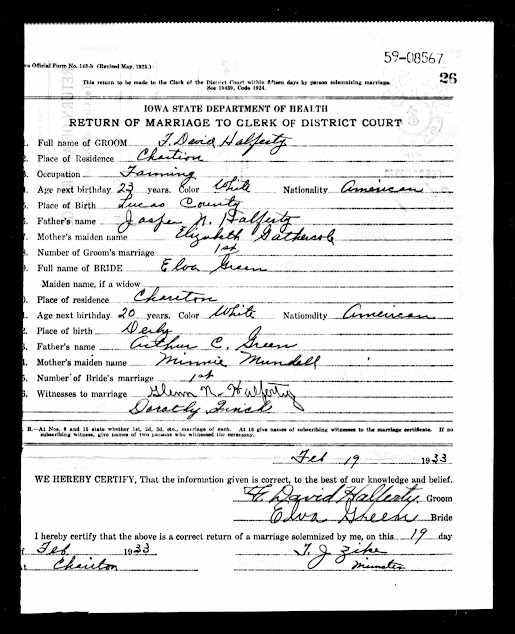So what about the life and times of the Rev. Mr. Evans, recognized at the time as a leading advocate for Wesleyan orthodoxy when confronted by various "isms" of the day --- Universalism, Spiritualism and Adventism among them?
Although he never served a church in Lucas County, the Rev. Mr. Evans was pastor during a 40-year career, from 1851 until 1890, of congregations all around, Albia, Oskaloosa, Knoxville and Osceola among them. Like most Methodist preachers of the day, his pastoral assignments were relatively brief and so he and his family were constantly on the move during those years, serving dozens and dozens of congregations.
That sort of dedication is one of the reasons why, as some have suggested, there was a Methodist church perched on every Iowa hilltop as the 19th century moved to its close and the denomination, now United Methodist, still is --- for the time being at least --- so deeply rooted in Iowa's soil.
The Rev. Mr. Evans died at his home in Des Moines of complications from appendicitis on Sept. 3, 1908, age 79 (he is buried in Woodland Cemetery) --- and his obituary, published in The Des Moines Register of Sept. 4, contains a good deal of information about him:
+++
The Rev. Mr. Evans was not only one of the oldest members of the Methodist conference, but was a charter member in the Odd Fellows lodge in the state and a pioneer Mason. He joined the Odd Fellows lodge in 1854.
He was born in Pittsburgh, March 17, 1829, and came to Iowa in 1839 and settled in Lee county. His education for the ministry was received at Fort Madison. He was appointed to the ministry by the annual conference in 1851 and continued in the church pastorates throughout Iowa for nearly forty years. He was a member of the first Methodist conference in Iowa and when that conference was divided was appointed to the Iowa conference. Among his charges through the state have been the churches at Burlington, Washington, Mount Pleasant, Albia, Ottumwa, Oskaloosa and Knoxville.
He retired from the ministry in 1890 and came to Des Moines to become a lecturer for the Odd Fellows lodge, of which he was grand chaplain, Masons, and on temperance subjects.
He was married Feb. 19, 1855, to Miss Martha Dickerhoff of Bloomfield. Of the four children born, William, the oldest child, died in infancy, and Mamie, Frank and Cora live at home.
The Rev. Mr. Evans was chaplain for the Thirty-fifth Iowa for two years during the Civil War.
The funeral will be held Sunday at 3 o'clock from the home. The services will be in charge of the Rev. Orien W. Fifer, assisted by the Rev. Charles P. Johnson, Dr. Emory Miller and other Methodist ministers in Des Moines.
+++
There's more to be found about his career as an advocate for Wesleyan orthodoxy in a 1900 book by Aaron W. Haines, "The Makers of Iowa Methodism" (Cincinnati: Jennings & Pye). Here are the relevant paragraphs:
In the year 1845, at the close of a temperance lecture by John Harris at a little country schoolhouse on the Birmingham Circuit, a boy was brought forward, and with a table as a platform gave a recitation which was so appropriate and so well done, that the old English preacher never got through telling of it. That boy was Frank W. Evans, and seven years later he was admitted into the Iowa Conference as a traveling preacher.
He was born in Pittsburgh, Pa., in 1829, and when but a boy of ten his father moved to Iowa, and located in Fort Madison, where he lived for five years, working at the trade of a shoemaker. In 1845, he moved to a farm in Van Buren County, where the boy grew to manhood amid such surroundings as were afforded in a new country. At an early age he gave his heart to God, and his service to the church. and most efficient service it was. For forty years he occupied a prominent place in the effective ranks of the Methodist hosts of Iowa, and after retirement was able to do valiant service in the pulpit and on the platform and rostrum.
Although small in stature, he was large in many other ways. To natural oratorical powers he added superior polemical skill, and in driving away "erroneous and strange doctrines" there has not arisen among the preachers of the West a greater than Francis W. Evans. for many y ears he was recognized as the champion debater. One of his early combats in the polemical field is recalled by the old settlers of Davis County. It was with the editor of Manford's Magazine, in that day recognized as the leading exponent of the tenets of the Universalists of the West. The debate was held in Drakesville, and lasted several days. Before it was over, Mr. Manford was forced to acknowledge that he had underrated his antagonist, having thought of him only as a boy, and therefore had not fully prepared himself. However that may have been, the advocates of universal salvation in that community were as the Midianites after the victory of Gideon, "they lifted up their heads no more."
There was only one time that he was almost inclined to admit that he had met with a defeat. He had met in debate a very prominent Adventist on the Sabbath question, and according to the verdict of many who had heard him had held his own; but he was not satisfied. He went home, bought all the literature he could find on the subject written from the standpoint of the opposition --- there was none published on his own side --- studied the Bible and history more thoroughly, and from these, coupled with original illustration, he formulated an argument which met every point in the controversy. He then sent a challenge to the leader of the Saturday-Sabbath people, Elder D. M. Canwright. It was accepted, and they met at Lexington, Iowa, in the summer of 1871. It was a time of great interest in all that section of the country, and at the close of the discussion, which continued about a week, the unanimous verdict was, that the little giant had won the day. His opponent afterward renounced the opinions he that day advocated.
Evans has met during his ministry able representatives of all the "isms" extant, and taken great delight in exposing their fallacies. With all this he has been a successful pastor and presiding elder. His early efforts in the temperance cause were followed up in after years, and he was an able advocate of every good cause. He has represented his Conference in the General Conference, and was recognized by his associates as an able Western man. He has published a work on "Spiritualism," which is an authority on that subject. He is spending his days of retirement in the city of Des Moines.


.jpg)

























